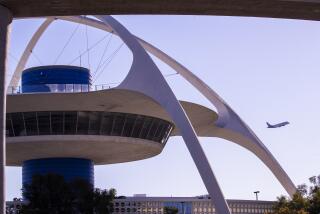U.S. Probers Blame the Pilots for Midair Crash in California
- Share via
WASHINGTON — Federal investigators concluded Thursday that the collision of a Wings West Airlines commuter plane and a private aircraft that killed 17 people near San Luis Obispo a year ago could have been avoided if the two pilots had checked a special radio frequency for other air traffic.
The National Transportation Safety Board also suggested that if either of the planes had flown under instrument flight rules, air traffic controllers at the Los Angeles control center in Palmdale probably would have been able to provide warnings that would have prevented the accident.
The two planes collided in clear weather on Aug. 24, 1984, shortly after the Wings West aircraft took off from San Luis Obispo Airport on a flight to San Francisco. The other plane, on an instrument training flight, was approaching to land at the airport.
The safety board said the likely cause of the collision was the failure of both pilots to “follow recommended communications and traffic advisory practices” that could have warned that their planes were on a collision course.
The board said that while the pilots were not required to monitor the radio frequency, it is recommended by the Airmen’s Information Manual and would have alerted the pilots.
Both aircraft transmitted on the frequency. The Wings West pilot monitored the frequency for five miles after takeoff but not long enough to hear transmissions from the single-engine Rockwell Commander that was coming in for a landing, the investigators said.
The safety board investigation concluded that both planes were on the radar screen at the Los Angeles Air Traffic Control Center. However, the board said that since the planes had elected to fly under visual flight rules, the controllers were correctly concentrating their attention on other parts of the airspace.
Board Chairman Jim Burnett said the board did not fault the controllers because their responsibilities were to pay attention to air traffic flying under instrument flight rules.
The board criticized the pilot of the Wings West aircraft for not taking off from San Luis Obispo under instrument flight rules, which would have prompted an air traffic controller to advise him of other traffic in the area.
While the commuter pilot requested a change from visual to instrument flight rules shortly after takeoff, the shift came only 28 seconds before the collision and did not give the controller time to log in the plane, switch his attention to that part of the radar screen and advise Wings West of other traffic, the board said.
Despite the clear skies, the two planes collided head-on, with the pilots noticing each other only seconds before impact.
Investigators said that under best conditions, the pilot of the small private plane probably saw the Wings West Beech 99 commuter craft only six to eight seconds before impact. The Wings West pilot probably saw the other aircraft only a few seconds earlier.
Head-on Course
Because the two aircraft were flying head-on, investigators said neither pilot would have had enough time to determine that they were on a collision course and take evasive action.
Board members said the collision raised questions about the adequacy of the so-called “see-and-avoid” philosophy that places heavy reliance on pilots avoiding each other without reliance on instruments or air traffic controllers.
“The facts of this accident demonstrate that there may be occasion in which the physical factors of a traffic conflict can approach or may even exceed the physiological capabilities of the pilots to see and avoid an oncoming airplane,” the safety board’s report said.
One of the three board members, Patricia Goldman, disagreed with the board’s probable cause, which criticizes the pilots for not following recommended procedures.
“We all agree there are deficiencies in the ‘see-and-avoid’ system. They (the other two board members) think its a factor in the accident, but not the cause. I think it’s the cause,” Goldman said.
More to Read
Sign up for Essential California
The most important California stories and recommendations in your inbox every morning.
You may occasionally receive promotional content from the Los Angeles Times.










